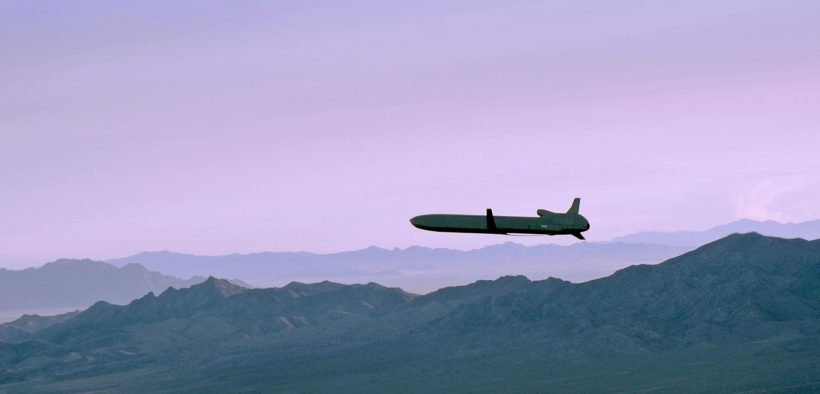Could it be Time for Australia to Consider Nuclear Weapons?

“There’s a massive shift in Australia’s strategic situation taking place.”
A new book by a former top Australian Defence Department official and intelligence analyst urges Australia to consider developing a nuclear arsenal to counter China’s rising power in the Pacific.
The book titled How to Defend Australia, by professor Hugh White, claims Australia’s non-nuclear weapon policy is no longer relevant, adding that China’s position as the most dominant power in the Asia Pacific region means Australia can no longer rely on U.S. or U.K. for security.
White also writes that Canberra should increase its defense budget (from two percent of GDP to three percent), given China continues to boost its own military spending.
“There’s a massive shift in Australia’s strategic situation taking place. For the first time since European settlement of Australia, we no longer can assume that we’ll have a strong military ally such as Britain or America as the dominant military power in the Pacific,” as White told 9News.com.
However, the professor recognized that there would be some adjustments needed if Australia were to boost its military expenditure, such as cuts in subsidies for education or health.
White also told 9News that Australia needed to alter its defense spending to focus on creating larger military forces. He said the development project of 12 submarines worth $50 billion designed by France should be stopped and replaced by 24 low-cost vessels, while also warning that the Australia Air Force needs to buy more than double the current 72 F-35 Joint Strike Fighter (JSF) to defend the country from air and sea strikes.
“The JSF plays a vital role in our defense. But I think we’re going to need a larger frontline fighter fleet. Instead of the total force of 100 fighters, we’ll probably need somewhere around 200,” White said.
Defense Secretary Snubs a Nuclear Australia
The defense analyst told 9News that he hoped his book will spark a debate in the government about the vital role of national defense, adding that Australia’s main political parties (Labour and Conservative) have not taken the issue seriously.
In his book, White argues U.S. power is waning and thus, stressed that Australian politicians should stop thinking that the U.S. is the dominant power in the Asia Pacific as they need a debate about how to protect the nation without relying on U.S. power.
Australia’s Defense Minister Linda Reynolds ignored White’s suggestion that the country should develop nuclear arsenals, adding that Australia is committed to the Non-Proliferation Treaty (NPT) which it signed in 1970.
“Australia stands by its Non-Proliferation Treaty pledge, as a non-nuclear weapon state, not to acquire or develop nuclear weapons,” Reynolds told the Sydney Morning Herald.
Two Proposals for a Nuclear Australia
Peter Layton, a defense expert at the Griffith Asia Institute, concurred with White’s assessment that Australia needs to go nuclear in an article for the Lowy Institute. Like White, Layton argued that China’s military presence in the contested South China Sea and the North Korean factor were reasons for the change in Australia’s nuclear stance. However, such a plan would face obstacles as Australia is a signatory of the NPT and the costs to develop nuclear weapons are high.
Layton proposed two potential solutions: First, Australia could share nuclear weapons with the U.S. (Germany, Holland, Italy, Belgium and Turkey already share such weapons with the U.S.). The arrangement involves a dual-key system, but the U.S. retains final say. Layton warns while this is an affordable option it is risky as it still relies on the U.S. providing final say and it still means Australia would need to obtain a long-range system capable of delivering a nuclear strike to China.
Layton’s second suggestion is that Australia and the U.K. share the development of Dreadnought-class nuclear submarines.
“The Dreadnoughts will be very hard to find, highly survivable and able to inflict enormous damage on adversaries of any size or sophistication. The first Dreadnought’s maiden patrol is planned for 2028.
“The U.K. is finding the cost of funding the Dreadnoughts very difficult. British defense spending cannot really fund both a conventional and a nuclear force. As such, the former is facing deep cuts to finance the latter, with the Royal Marines and associated amphibious ships possible near-term causalities,” Layton wrote for the Lowy Institute.
Others Argue Cyber Security Should be Australia’s Focus
In response to White’s latest book, former army chief Peter Leahy and senior analyst Rory Medcalf argued that an Australian plan to arm with a nuclear defense is too risky, and increases the threat of nuclear weapons getting out of control.
Leahy told the Sydney Morning Herald that more nuclear-equipped countries “creates more risk: risk of suspicion, risk of first use, risk of the weapons being seized or falling under the control of non-state actors.”
While Medcalf told the Herald that Australia should instead focus on cybersecurity.
“Australia needs to maintain its military capability. But it should more focus on strengthening cybersecurity as it poses more danger than conventional strike.
“Australia has the capacity to be a major cyber power. If a major country was trying to threaten us, why would it opt for something like an invasion when the smart, 21st-century thing to do would be to cripple our critical infrastructure and achieve political submission that way,” Medcalf told the Herald.
The Australian Strategic Policy Institute’s International Cyber Policy Centre (ICPC) released a report on Monday, July 1, which revealed that Australia’s crucial government infrastructure is at critical risk of a cyber attack.
The institution also reported on the shortcomings of Australia’s infrastructure providers, such as inadequate knowledge about operational system risks and solutions.
“Over the next couple of years we can see a lot of significant development with the Internet of Things, 5G, and a range of new capabilities coming along that will mean we’ll start connecting these systems up and making them much more useful and valuable, but also much more liable to hacking,” Report author Rajiv Shah told Government News.
In 2017, Australia launched a Critical Infrastructure Center which “works across all levels of government, and with owners and operators to identify and manage the risks to Australia’s critical infrastructure,” as their website states.
However, Shah explained to Government News that while Australia’s framework is in place to safeguard against cybersecurity attacks they are under-resourced.
“What they need to be doing is getting the resources to make sure our critical infrastructure providers are aware of the issues,” Shah said.
“It’s really about getting ahead of the curve. The history of the internet shows that we tend to do something and then work out how to secure it later. We need to do the work now.”








If I understand world history correctly — and I think I do — an arms race is an overture to war. I wonder exactly what threat China poses to Australia. What actually threatens to destroy Australia — global warming, which in Australia amounts to superheating — has already gone a long way toward that end, hasn’t it?
No. Man-made climate change is a total myth!